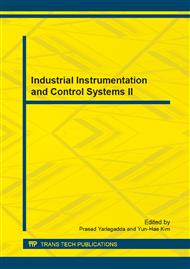[1]
N. Xu, S. Rangwala, K. K. Chintalapudi, D. Ganesan, A. Broad, R. Govindan and D. Estrin, A Wireless Sensor Network for Structural Monitoring, Proc. of ACM SenSys, (2004).
DOI: 10.1145/1031495.1031498
Google Scholar
[2]
Z. Yang and Y.H. Liu, Quality of Trilateration: Confidence based Iterative Localization, IEEE Transactions on Parallel and Distributed Systems (TPDS), vol. 21, no. 5, pp.631-640, May (2010).
DOI: 10.1109/tpds.2009.90
Google Scholar
[3]
S. Samarah, M. Al-Hajri and A. Boukerche, A Predictive Energy-Efficient Technique to Support Object-Tracking Sensor Networks, IEEE Transactions On Vehicular Technology, vol. 60, no. 2, pp.656-663, (2011).
DOI: 10.1109/tvt.2010.2102375
Google Scholar
[4]
M. Di Francesco, S. Das, G. Anastasi, Data Collection in Wireless Sensor Networks with Mobile Elements: A Survey, ACM Transactions on Sensor Networks, vol. 8, no. 1, August (2011).
DOI: 10.1145/1993042.1993049
Google Scholar
[5]
S. Nesamony, M. K. Vairamuthu and M.E. Orlowska, On Optimal Route of a Calibrating Mobile Sink in a Wireless Sensor Network, Proc. of INSS, pp.61-64, (2007).
DOI: 10.1109/inss.2007.4297389
Google Scholar
[6]
M. Gatzianas and L. Georgiadis, A Distributed Algorithm for Maximum Lifetime Routing in Sensor Networks with Mobile Sink, IEEE/ACM Transactions on Wireless Communications, vol. 7, no. 3, pp.984-994, Mar. (2008).
DOI: 10.1109/twc.2008.060727
Google Scholar
[7]
M. Zhao and Y. Yang, Bounded Relay Hop Mobile Data Gathering in Wireless Sensor Networks, IEEE Transactions on Computers, 61, no. 2, pp.265-277, (2012).
DOI: 10.1109/tc.2010.219
Google Scholar
[8]
T.H. Cormen, C.E. Leiserson, R.L. Rivest, and C. Stein, Introduction to Algorithms, second ed. The MIT Press, (2001).
Google Scholar
[9]
A. Srinivasan and J. Wu, TRACK: A Novel Connected Dominating Set based Sink Mobility Model for WSNs, Proc. of ICCCN, pp.664-671, (2008).
DOI: 10.1109/icccn.2008.ecp.127
Google Scholar
[10]
W.J. Liu, Y. Sun, Y. Bai, J.G. Yu and B.X. Cao, DCR: An Energy-Efficient Distributed Clustering and Routing Protocol for Wireless Sensor Networks, Proc. of ICCSN, pp.786-790, (2009).
DOI: 10.1109/iccsn.2009.175
Google Scholar


